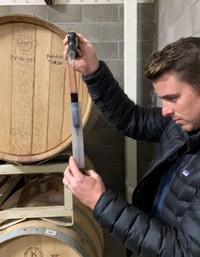Rangeland Terroir and Technique Part 2, In the Cellar
Last fall, I left off describing the barreling down of the 2021 harvest. While winter and spring are not as bustling as harvest time, there is plenty to do in the cellar “offseason.” One of the ongoing challenges in winemaking is that there are at least two vintages in the winery at any time. Currently, while the 2020 vintage is approaching bottling, the 2021 vintage needs to be tasted and blended.
The overall quality of the 2021 vintage is exceptional with ample color, texture, and depth. It’s the sort of vintage that makes any winemaker’s job easy and fun. The tricky part comes with the myriad possible blends. In prior years, we’ve waited until near bottling to complete our wine blends, but I like to blend earlier in elevage (raising and nurturing of wine). Just like slow cooking, it’s often best to get all the ingredients in early to integrate. We start this process after the wine has gone through primary fermentation (yeast converts sugar to alcohol and carbon dioxide) and malolactic fermentation (bacteria converts malic acid into softer lactic acid), roughly a few months after harvest. I then use a minimal addition of sulfur dioxide to prevent oxidation and browning of the wine before I begin racking and blending.
Racking is the process of using gravity and inert gas pressure to move wine from barrel, off its fine lees (sediment). In this case, we are racking to a tank to blend varieties or lots. Then we transfer the wine back to barrel to integrate and age. Early racking aids in retaining fresher aromatics and a softer texture. Lees may have some complex aromatics but can also hold onto some grippier tannin. I use racking on a case-by-case basis; for example, “bigger” varieties such as Petit Verdot can improve with softer tannin, while some of the complexities of a lighter Grenache sitting on lees are best left alone.
 We begin the blending process by tasting every barrel of wine; roughly 60 barrels. I take notes on which wines work best with the newer barrels. If I don’t like the taste of a particular barrel on a wine, I can switch it up after racking and blending. About 25% of our barrels are new and can add sweet tannin and toasty warm flavors to our wines. The other 75% of our barrels are deemed “neutral.” These barrels are depleted of oak flavors and merely used as storage vessels while allowing limited amounts of oxygen into the wines to soften tannin and allow flavors to evolve.
We begin the blending process by tasting every barrel of wine; roughly 60 barrels. I take notes on which wines work best with the newer barrels. If I don’t like the taste of a particular barrel on a wine, I can switch it up after racking and blending. About 25% of our barrels are new and can add sweet tannin and toasty warm flavors to our wines. The other 75% of our barrels are deemed “neutral.” These barrels are depleted of oak flavors and merely used as storage vessels while allowing limited amounts of oxygen into the wines to soften tannin and allow flavors to evolve.
Barrels, like grapes, are produced from many different terroirs and express a wide range of styles from various coopers. Most of ours are from France, although we have a few from eastern Europe. It takes a lot of trial and error to match the right barrels with our wine and terroir. On our full-bodied wines, we will be looking for a barrel that can bring more structure to the palate, and on our brighter wines we may want a barrel that adds richness.
It often takes ten to fifteen mock-up blends to get a single wine hitting the right notes of energy, depth, and focus while remaining representative of our terroir, the vintage, and the varieties. Since it’s my first year here at Rangeland, all possible blends are on the table. These combinations are further complicated when considering our diverse soil types. Wines like the Limestone Cabernet Sauvignon can be straightforward to blend, because the energetic limestone terroir is the focus. By contrast, the Watershed and Shepherd blends are a culmination of our top lots from different soil types within a vintage. These two wines go through the most rigorous blending process in our lineup. Limestone soils impart energy, bright fruits, and tension. Sandstone soils bring density, broad tannin, and richness to the wine. Also, due to the droughty nature of the sandstone soils, we pick earlier in those blocks, which lends seductive herbaceous and savory notes often found in classic wines. I run many of these samples by Laird, Lisa and the team to get their feedback and inform my final decisions. Generally, blending is a game of Tetris trying to bring our favorite blocks into the right fit with one another. Once we rack and blend these wines, it’s back to barrel for aging until bottling the following year.
Next time, in Part 3, I’ll cover the second year in the barrel leading up to bottling. Cheers!
Comments
Commenting has been turned off.Keep up to date on the latest wine releases, events, and promotions and get 10% off your next order.